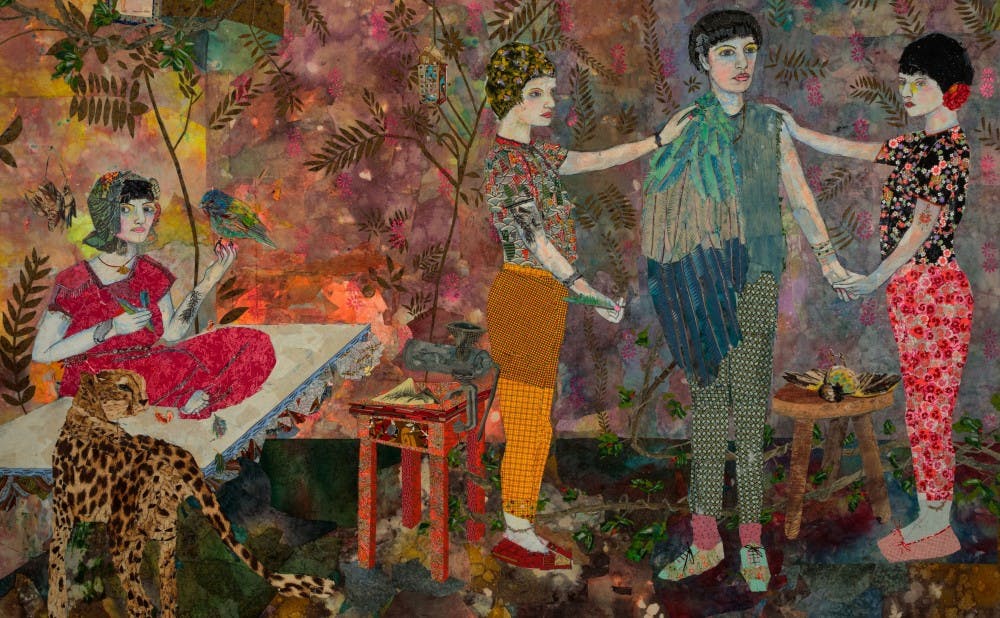In the Nasher Museum of Art’s new exhibition, viewers discover a contemporary photograph next to ancient Greek artifacts, and even find reflections of themselves on mirrors behind pictures from the 1960s.
On Sept. 1, the museum opened its new exhibition, “People Get Ready: Building a Contemporary Collection.” Organized by Trevor Schoonmaker, deputy director of curatorial affairs, the exhibition displays works mainly by underrepresented artists throughout history to shed light on their forgotten messages and stories. It extends into the Wilson Pavilion.
All of the displayed works in exhibition come from the collection that the museum has built throughout the past 12 years. While some works are new acquisitions, others even date back to the days of the Duke University Museum of Art.
“The exhibition represents a culmination of all of these years of collecting, and we finally have a critical mass of works that can be put together in a full pavilion,” Nasher Director Sarah Schroth said.
Deriving its name from a 1960s soul song inspired by the civil rights movement, the exhibition reveals the museum’s particular interest in integration of diverse identities into artworks and representation of artists of color in the contemporary world. The artists of the works range from a relatively less known Native American artist whose work recently got discovered to more prominent artists of color like Fred Wilson.
“It’s important for us here at Duke as an institution of learning to be considering and celebrating all identities and perspectives,” Jessica Ruhle, director of education and public programs, said. “Within the city of Durham, it is [also] important for us to be showing works that more broadly reflect our community.”
In the exhibition, works such a family tree with figures composed of images cut out from magazines and a life size portrait of a woman with her face covered with a T-shirt draw viewers’ attention. Such potent works engage visitors into conversation topics that they do not often discuss in their everyday lives.
“[The works]...become the reasons for conversations that can be very civil,” Ruth Caccavale, lead gallery guide and museum educator, who will be leading tours of the exhibition, said. “[They] bring people out of their comfort zones, but not in a way that is so confrontational, because people expect to look at [works] of art and discuss [them].”
Frequent visitors of the museum may discover that some of the works in the galleries have previously been displayed. In the current exhibition, the works are put into different conversations with new artworks that the public have never seen. Such juxtaposition not only provides insight into the works that the Nasher values, but also reveals the ways in which social changes influence the kind of works that are created and shown.
“[The exhibition] does allow the viewers to see a work with a new eye and reconsider what maybe is an old favorite from the Nasher’s collection alongside a new piece that either we have added or have not installed in the past,” Ruhle said. “Those conversations [among the works] can also reflect what has changed within society… and how we interpret any particular work and pairing within galleries.”
The ways in which artworks are organized in the exhibition also deliver strong messages to viewers; seeing pictures from the civil rights movement attached to mirrors and a school desk made up of erasers in the same room brings into question whose history gets to be told, while others’ get forgotten.
Meanwhile, “People Get Ready” is the museum’s bold attempt to put its contemporary collection into conversation with its historical collection. For the first time in the museum’s history, visitors will find a painting by a contemporary African American artist and European old master paintings in the same gallery.
“In the past, the historical collection seemed a little disconnected from the contemporary collection,” Wendy Hower, director of engagement and marketing, said. “And now, I feel like it is easier to tell the story of the Nasher Museum and why it is unique, because the contemporary works are now, for the first time, in conversation with the historical works.”
Such a new move will allow visitors to connect artworks from diverse time periods and countries. The exhibition also accentuates the importance of discovering aspects that the historical collection could not reveal on its own such as the continuing influence of European colonialism in African-American artworks.
Directors and educators agreed that they want visitors to discover conversations among artworks by artists from different backgrounds, while establishing personal connections to the works.
“My hope with visitors in any of our galleries is that they will find ways that the art connects to their own experiences and with [those ways], the art allows them think about, consider and reflect upon the experiences of others,” Ruhle said.
Get The Chronicle straight to your inbox
Signup for our weekly newsletter. Cancel at any time.

